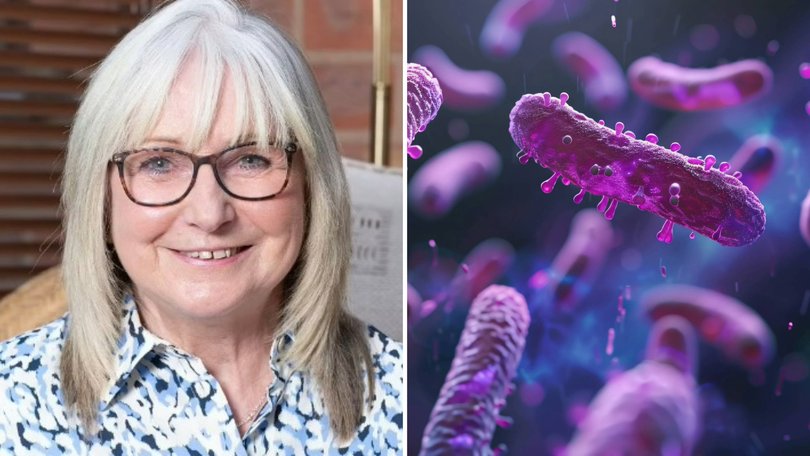Necrotising fasciitis: How a tiny cut left Sue Wheatley fighting for her life with a flesh-eating infection

Grandmother Sue Wheatley was rinsing out a tin of crab meat when she cut her finger on the sharp lid.
The wound was only about a centimetre long, so she put a plaster on — and didn’t think much more about it. But within two weeks, this innocuous wound left her in a ten-day coma, fighting for her life.
Bacteria that appears to have entered via the cut had penetrated deep into Sue’s body, causing a dangerous infection called necrotising fasciitis (NF) — often known as the flesh-eating disease for the speed at which it destroys tissue such as muscle, skin and other tissues. A fortnight after cutting her finger — which had by then healed — Sue spent the morning collecting litter for a neighbourhood scheme when she noticed her right shoulder feeling sore.
Sign up to The Nightly's newsletters.
Get the first look at the digital newspaper, curated daily stories and breaking headlines delivered to your inbox.
By continuing you agree to our Terms and Privacy Policy.“I just thought I had pulled a muscle,” says Sue, 64, a retired administrator from Dudley, in the West Midlands, who has two grown-up children and three grandsons. “But only a few hours later I was in agony, with pain along my arm and in my chest — like I was having a heart attack. I was also getting hot and cold shivers, so I got into bed.”
Her husband, Paul, 66, a retired company director, called NHS 111 — the operator said the symptoms sounded serious and sent an ambulance to take Sue to hospital. In A&E, Sue’s health rapidly declined.
“I started being sick repeatedly,” she says of the event in June 2023. She was admitted to a ward: “I was in intense pain all over and, by the next morning, the skin of my whole right arm had turned black and bruise-coloured and started seeping colourless liquid through the skin.”
Sue is one of a small but growing number of people in the UK who develop NF, as rates of the life-threatening condition have increased since the pandemic — possibly as we’re still feeling the effects on our immune systems. Typically, there are about 1,000 cases of NF a year in the UK, according to the Lee Spark NF Foundation — named after a previously healthy 23-year-old who died from the condition in 1999.
But data from a recent poll of 28 hospitals across England, presented at a British Association of Plastic Reconstructive and Aesthetic Surgeons (BAPRAS) conference in Newport, Wales, in December, shows that 57 per cent reported an increase in the number of patients affected in 2023, compared with previous years.
A drop in immunity
This is thought to be owing to a drop in immunity as lockdowns and social distancing prevented people building resistance to common bugs.
NF typically occurs when bacteria that many people carry harmlessly on their skin or in their throats get deep into the body, generally through a wound, graze or their blood supply; the recent rise has been linked to Strep A, a common cause of tonsillitis and scarlet fever (more on this later).
When it reaches the fascia, thin connective tissue that lies over muscles, blood vessels and around organs, the invading bacteria can start rapidly spreading, secreting toxic chemicals that kill the soft tissue.
Even with treatment (which usually includes emergency surgery and antibiotics) up to 30 per cent of patients die, reported a study in the journal BMC Infectious Diseases in 2021.

Those who survive often have had amputations to stop the spread of the infection, and skin grafts after extensive surgery to remove infected tissue.
The recent poll, by Sheffield Teaching Hospitals NHS Foundation Trust, was initiated by plastic surgeons based there, who had noticed an increase in cases — 27 in 2023, compared with an average of eight cases a year between 2019 and 2022. The team contacted other hospitals and found that almost six out of ten had noticed a similar rise, says Dr Helen Richards, a consultant plastic surgeon at Sheffield, and one of the doctors who initiated the poll.
Increases have also been reported in Japan, Germany and Switzerland, she says. “The emerging evidence suggests it is a global phenomenon, with growing numbers of cases after the pandemic. We want to raise awareness without causing unnecessary alarm; NF remains rare.”
The Sheffield research found more cases were now caused by group A Streptococcus (Strep A) than before the pandemic.
This bacterium was found in 39 per cent of cases since the pandemic, compared with 27 per cent in previous years. A newer, more aggressive strain of strep A is believed to be behind this post-pandemic surge of invasive infections such as NF, researchers from the UK Health Security Agency reported earlier last year.
Initial symptoms
Common initial symptoms of NF include swelling and redness, as the bacteria invade and ravage the soft tissue. The key sign to look out for is severe, agonising pain in the affected area after a cut or injury, disproportionate to any visible signs, caused as the infection spreads along the deep tissues.
As infection spreads to the skin (which can take three to four days typically, although it can be faster and slower than this), it can cause blisters, a black or purple rash and shiny stretched skin, experts warn.
The invading bacteria produce toxins that can cause vomiting and diarrhoea, which can be misdiagnosed as food poisoning. But most critically, as the patient becomes seriously ill — which can happen in a matter of hours — they can develop life-threatening complications.
These include toxic shock (caused by the poisonous toxins) and sepsis (when the immune system overreacts to an infection and starts attacking its own tissues), both of which can be fatal.

People with diabetes, high blood pressure, or on steroid medication are at higher risk of NF because they have higher risk of infections generally — but NF can affect anyone of any age, too. It’s not clear why some people will have bacteria on or near a wound and not develop the condition, while others will.
“You need a perfect storm of factors to come together to get NF, and the patients who do are incredibly unlucky,” says Dr Marina Morgan, a consultant in clinical microbiology and infection at the Royal Devon University Healthcare NHS Foundation Trust.
But it is a medical emergency: “The bacteria multiply every 20 minutes on the fascia, spreading very quickly. It is hidden and difficult to know it is happening.”
Dr Morgan adds: “The one question that will save most patients being misdiagnosed, is to ask how bad is the pain? If the pain is eight to ten out of ten, think about necrotising fasciitis.” (Taking ibuprofen can worsen the condition by dampening down the immune system, she says.)
Time is critical
Time is critical: NF needs to be quickly identified — which can be challenging as doctors may only come across it once or twice in their careers — and the patient given high-dose antibiotics and surgery, to cut away the dead tissue where the bacteria are rapidly multiplying.
“As we are operating, we can sometimes see the dead tissue spreading in front of our eyes — the bacteria advances that quickly,’ says Dr Richards. Several operations to repeat the process may be needed over a few days. Patients who continue to deteriorate may be given immunoglobulin (immune cells extracted from donated blood) to help neutralise the poisonous toxins secreted by the bacteria. In Sue’s case, hospital doctors initially diagnosed her with cellulitis (an infection of the deeper layers of skin).
She was given antibiotics, but as the skin on her arm turned a blackish colour the next day, necrotising fasciitis was suspected and she was rushed to surgery — large sections of dying skin and muscle in her arm were cut away, particularly on the inside of her forearm.
She was taken back to theatre three days later to cut away more dead tissue, this time from her back. Skin grafts from her legs were taken to cover the open wounds on her arm and back, in further operations.
“At this point, my kidneys shut down and I had a machine breathing for me in intensive care,” recalls Sue.
“My heart was also struggling and I was in a coma for ten days.
The doctors told Paul and the children I only had a 50 per cent chance of surviving.’ Despite their worst fears, Sue slowly recovered. “When I left hospital after six weeks, I needed a frame to walk,” she says.
“Now, 20 months later, I still don’t have any sensation between my wrist and elbow and my grip is weaker, but I can write and drive.
“More than anything I feel so lucky to be here — I know many people don’t survive this condition. I’m so thankful.”
